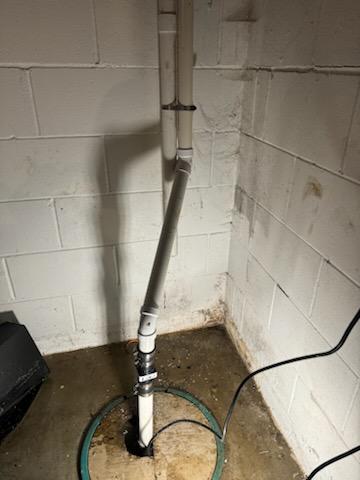Sump pumps are the unsung heroes of our homes, quietly toiling away in the shadows to ensure that our basements stay drier than a desert in July. These industrious devices work behind the scenes, preventing unwanted indoor swimming pools that could make even Michael Phelps cringe. However, like any hardworking employee, they can encounter issues—be it a motor breakdown or a float switch throwing a tantrum—leading to catastrophic consequences like surprise basement floods that turn your weekend plans into an unwelcome episode of “Survivor: Basement Edition.” So, let’s dive into the world of sump pump repairs, where we can discover how to keep this crucial equipment running smoothly and your home free from unintended aquatic adventures!
Understanding Sump Pumps:
At its core, a sump pump is a drainage system designed to remove excess water from your basement or crawl space, helping to prevent flooding and water damage. It functions like a tiny superhero, tirelessly working to keep moisture at bay, allowing you to enjoy a dry, usable space below your home. Whether it’s due to heavy rain, melting snow, or a looming water table, a sump pump acts as your first line of defense, ensuring that your foundations remain solid and your valuables remain untouched by water. When it comes to selecting the right sump pump for your needs, you’ll typically encounter two main types: submersible and pedestal pumps. Submersible pumps are like the ninjas of the drainage world—sleek, powerful, and designed to sit directly in the sump pit, submerging themselves in the water they efficiently remove. They are known for being quieter and having a longer lifespan due to their protective casing. Pedestal pumps, on the other hand, stand tall and proud above the water level, making them easier to access for maintenance. They are typically less expensive and ideal for smaller spaces, but their exposed design may lead to a bit more noise during operation, like that one friend who never quite mastered the art of indoor voice. Every sump pump consists of key components that work together to ensure effective drainage. The most critical piece is the pump itself, which houses an impeller that moves water to the discharge pipe. You’ll also find a float switch, which acts like a lifeguard at the pool, monitoring the water level and signaling the pump when it’s time to spring into action. The sump pit, where all the magic happens, collects the water, while the discharge pipe directs it away from your home’s foundation, preventing any potential flooding. These components work harmoniously to keep your basement dry, which is not just a relief for you but also an incentive for your houseplants to thrive instead of staging a coup against your flooring!
Signs Your Sump Pump Needs Repair:
Keeping an eye on your sump pump is crucial for maintaining a dry basement, and there are several telltale signs that it might be time to give it some extra attention—because ignoring these issues could lead to a flood of problems! One of the most noticeable indicators is constant cycling—when your pump switches on and off repeatedly in a short period. This erratic behavior can be a sign of issues such as a malfunctioning float switch or an overloaded motor that is struggling to keep up with the demands placed on it. Additionally, unusual noises such as grinding or rattling should set off alarm bells. If your sump pump sounds like it’s auditioning for a rock band instead of quietly doing its job, it’s time to investigate further. Noisy pumps can signal mechanical failures or blockages that could hinder performance when you need it most—after all, you don’t want a pump that’s too ‘washed up’ to handle a downpour!
Another critical sign that your sump pump might need repairs is a lack of operation during periods of heavy rainfall or flooding. If you’ve recently encountered a storm and the pump has failed to activate, you may be in for a surprise when you check your basement—talk about a water works production! Keeping an eye on water levels in the sump basin itself is also essential—if you notice increased water levels and your pump isn’t responding, it’s a clear indicator of trouble. Lastly, visible wear and corrosion on any parts of the sump pump can spell disaster down the line. Corrosion can weaken components, leading to complete pump failure over time. Taking proactive steps to address these warning signs can save you from a soggy situation and ensure that your sump pump remains an unwavering shield against unwanted water intrusion—no one likes a ‘drain’ on their spirits!
Common sump pump issues:
Can arise from a variety of sources, each posing a significant risk to the effectiveness of your drainage system. Power supply problems can leave your pump in the dark when it’s needed most, while clogged discharge lines can obstruct the water flow, creating a potential backup in your basement. A faulty float switch may prevent the pump from activating at the right times, making it a real float-tastrophe! Additionally, a frozen discharge pipe can turn a reliable pump into an ice sculpture, rendering it useless in cold weather. Motor failure is another major hiccup that can halt operations completely, and if you’ve got battery backup issues, you might find yourself surprised by a flood during power outages. Keeping an eye on these common pitfalls is crucial for ensuring your sump pump remains in tip-top shape!
Repairing Your Sump Pump:
Understanding when to tackle repairs on your own versus when to call in a professional can make all the difference in maintaining an efficient, functioning sump pump. If you’re the handy type and have a bit of experience under your belt, there are several simple fixes you can try yourself. For instance, routine cleaning of the sump basin is crucial for the smooth operation of the pump and can be a straightforward task. Often, debris such as dirt, leaves, or even small stones can accumulate in the pit, preventing the float switch from working properly. Carefully removing this debris can help restore your pump’s functionality without much hassle. Similarly, checking the power supply is a vital first step when troubleshooting pump issues. It only takes a moment to inspect the power cord for any visible damage or to ensure that the pump is plugged in and receiving electricity. These small maintenance tasks are often manageable for homeowners and can save time and money—but it’s essential to know your limits and when you might be in over your head.
However, there are definitely times when it’s best to leave sump pump repairs to the professionals. Complex problems that require expertise should not be underestimated; issues like a faulty float switch or a motor malfunction may seem minor but can be difficult to diagnose and fix without technical knowledge. A professional can quickly assess these issues, providing a clearer understanding of what’s wrong and suggesting the best course of action. Another compelling reason to call for expert help is the need for a thorough assessment of the pump’s overall condition, especially if you notice persistent issues or have an older model. Professionals have the experience and tools to provide a comprehensive evaluation, identifying potential weaknesses or underlying problems that might lead to failure later on. Attempting to address complex issues without the proper skills can not only result in further damage to the pump but can also pose safety risks. Ultimately, while DIY repairs can save money in more straightforward cases, enlisting a professional’s expertise for complex problems ensures that your sump pump will function optimally, safeguarding your home from unwanted water damage in the long run.
Repair vs. Replacement:
When faced with a malfunctioning sump pump, homeowners often wrestle with the decision of whether to repair the existing unit or invest in a new one. Several critical factors should be taken into consideration when evaluating the feasibility and advisability of repairs. The first and foremost aspect is cost-effectiveness. Before proceeding with any repair, it’s essential to weigh the expense of the repair against the functionality of the pump. If the cost of fixing issues like a faulty float switch or motor failure is substantial compared to the total cost of a new pump, then it may not make financial sense to proceed with repairs. Additionally, the age of the pump plays a vital role in this decision-making process. Most sump pumps have a lifespan of approximately 10 years, and as they age, they are more prone to developing problems. If your current pump is nearing or past this age, investing in repairs might only offer a temporary solution rather than a long-term fix. Furthermore, consider the frequency of issues that your sump pump has experienced. If you find yourself frequently calling for repairs or troubleshooting problems, it may be indicative of an underlying issue that a simple fix won’t resolve. Chronic problems can be a sign that the pump is nearing the end of its useful life, leading to the logical conclusion that a replacement might be in order.
On the other hand, opting for a replacement has its own distinct advantages that can make it an attractive option. One of the most significant benefits is improved efficiency. Modern sump pump models are designed with advanced technology that not only makes them quieter but also enhances their energy efficiency, resulting in lower energy bills. This improvement can be particularly beneficial if your current pump has been consuming more electricity than necessary, which is often the case with older units. Additionally, purchasing a new sump pump typically comes with new warranty benefits, offering peace of mind and protection against potential defects or failures for a specified period. Warranties can cover the costs of repairs and parts, mitigating the financial burden should issues arise shortly after installation. Finally, long-term reliability is a crucial consideration; investing in a new, high-quality sump pump means that you’re reducing the risk of future breakdowns, ensuring optimal performance in every situation, especially during heavy rains or flooding events. This reliability translates not only into a dry basement but also into a significant reduction in the stress and anxiety associated with unexpected water damage. In the grand scheme, while repairs might provide an immediate solution, the benefits of a replacement—especially in terms of efficiency, warranty security, and peace of mind—often justify the initial investment, setting you on a pathway for long-term success in protecting your home from water-related issues.





